SKODA OCTAVIA TOUR 2009 1.G / (1U) Owner's Manual
Manufacturer: SKODA, Model Year: 2009, Model line: OCTAVIA TOUR, Model: SKODA OCTAVIA TOUR 2009 1.G / (1U)Pages: 226, PDF Size: 13.11 MB
Page 161 of 226

Fuel
160
Unlocking
– Open the boot lid and remove the right inner paneling.
– Pull on the control cable in direct ion of arrow in order to unlock the
fuel filler flap ⇒page 159, fig. 149 .
WARNING
When unlocking the fuel fi ller flap manually, pay attention to sharp edges of
the body - risk of injury!s2ig.book Page 160 Monday, November 10, 2008 11:20 AM
Page 162 of 226
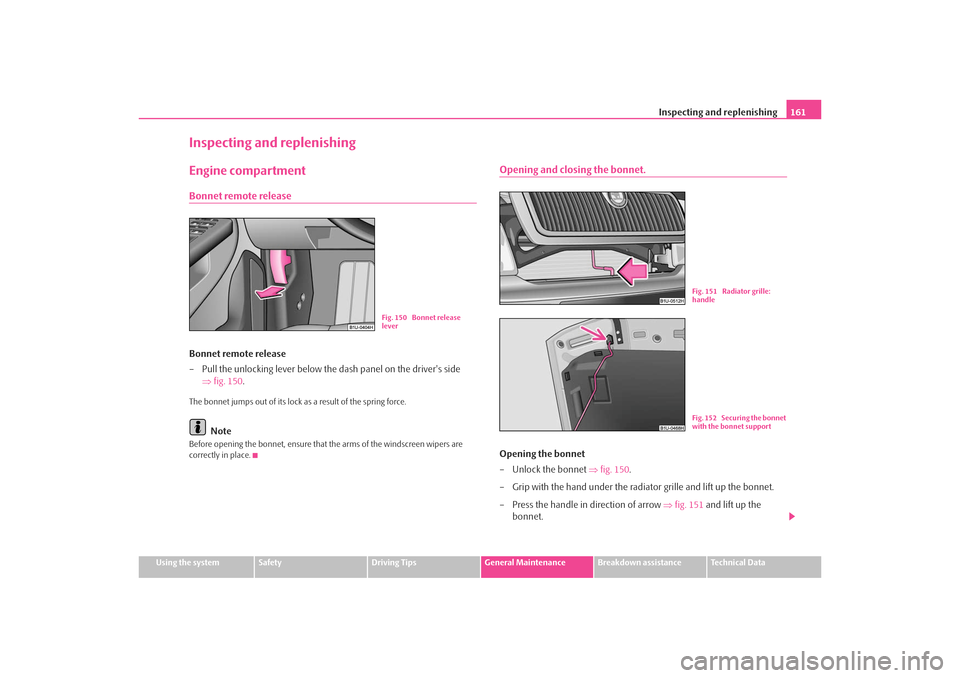
Inspecting and replenishing161
Using the system
Safety
Driving Tips
General Maintenance
Breakdown assistance
Technical Data
Inspecting and replenishingEngine compartmentBonnet remote releaseBonnet remote release
– Pull the unlocking lever below the dash panel on the driver's side
⇒ fig. 150 .The bonnet jumps out of its lock as a result of the spring force.
Note
Before opening the bonnet, ensure that the arms of the windscreen wipers are
correctly in place.
Opening and closing the bonnet.Opening the bonnet
– Unlock the bonnet ⇒fig. 150 .
– Grip with the hand under the radiat or grille and lift up the bonnet.
– Press the handle in direction of arrow ⇒fig. 151 and lift up the
bonnet.
Fig. 150 Bonnet release
lever
Fig. 151 Radiator grille:
handleFig. 152 Securing the bonnet
with the bonnet support
s2ig.book Page 161 Monday, November 10, 2008 11:20 AM
Page 163 of 226
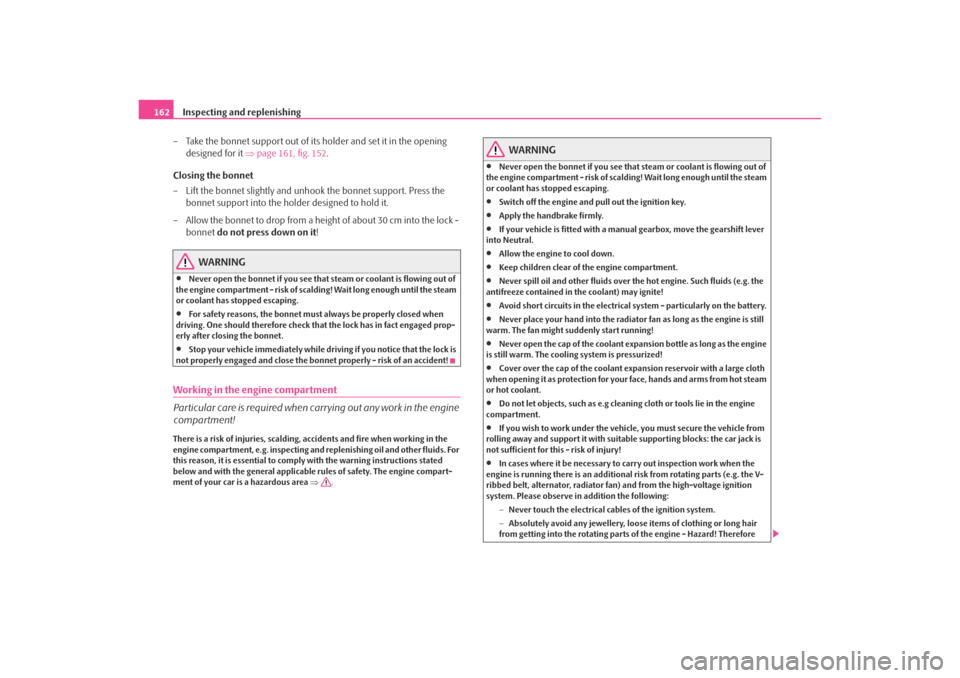
Inspecting and replenishing
162
– Take the bonnet support out of its holder and set it in the opening designed for it ⇒page 161, fig. 152 .
Closing the bonnet
– Lift the bonnet slightly and unhook the bonnet support. Press the bonnet support into the hold er designed to hold it.
– Allow the bonnet to drop from a height of about 30 cm into the lock - bonnet do not press down on it !
WARNING
•
Never open the bonnet if you see that steam or coolant is flowing out of
the engine compartment - risk of scaldi ng! Wait long enough until the steam
or coolant has stopped escaping.
•
For safety reasons, the bonnet must always be properly closed when
driving. One should therefore check that the lock has in fact engaged prop-
erly after closing the bonnet.
•
Stop your vehicle i mmediately while driving if yo u notice that the lock is
not properly engaged and close the bonn et properly - risk of an accident!
Working in the engine compartment
Particular care is required when carrying out any work in the engine
compartment!There is a risk of injuries, scalding, accidents and fire when working in the
engine compartment, e.g. inspecting an d replenishing oil and other fluids. For
this reason, it is essential to comply with the warning instructions stated
below and with the general applicable rules of safety. The engine compart-
ment of your car is a hazardous area ⇒ .
WARNING
•
Never open the bonnet if you see that steam or coolant is flowing out of
the engine compartment - risk of scaldi ng! Wait long enough until the steam
or coolant has stopped escaping.
•
Switch off the engine and pull out the ignition key.
•
Apply the handbrake firmly.
•
If your vehicle is fitted with a manual gearbox, move the gearshift lever
into Neutral.
•
Allow the engine to cool down.
•
Keep children clear of the engine compartment.
•
Never spill oil and other fluids over the hot engine. Such fluids (e.g. the
antifreeze contained in the coolant) may ignite!
•
Avoid short circuits in the electrical system - particularly on the battery.
•
Never place your hand into the radiator fan as long as the engine is still
warm. The fan might suddenly start running!
•
Never open the cap of the coolant expa nsion bottle as long as the engine
is still warm. The cooling system is pressurized!
•
Cover over the cap of the coolant expansion reservoir with a large cloth
when opening it as protection for your face, hands and arms from hot steam
or hot coolant.
•
Do not let objects, such as e.g cleaning cloth or tools lie in the engine
compartment.
•
If you wish to work under the vehicl e, you must secure the vehicle from
rolling away and support it with suitable supporting blocks: the car jack is
not sufficient for this - risk of injury!
•
In cases where it be necessary to carry out inspection work when the
engine is running there is an additional risk from rotating parts (e.g. the V-
ribbed belt, alternator, radiator fan) and from the high-voltage ignition
system. Please observe in addition the following:
−Never touch the electrical cabl es of the ignition system.
− Absolutely avoid any jewellery, loose items of clothing or long hair
from getting into the rotating part s of the engine - Hazard! Therefore
s2ig.book Page 162 Monday, November 10, 2008 11:20 AM
Page 164 of 226
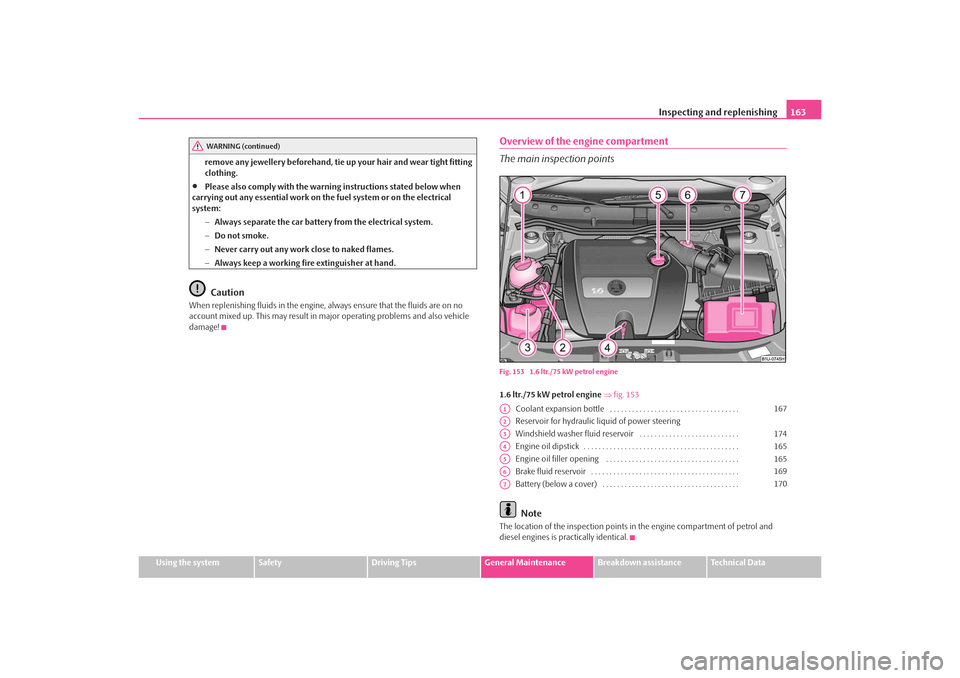
Inspecting and replenishing163
Using the system
Safety
Driving Tips
General Maintenance
Breakdown assistance
Technical Data
remove any jewellery beforehand, tie up your hair and wear tight fitting
clothing.
•
Please also comply with the warnin
g instructions stated below when
carrying out any essential work on the fuel system or on the electrical
system:
−Always separate the car batter y from the electrical system.
− Do not smoke.
− Never carry out any work close to naked flames.
− Always keep a working fire extinguisher at hand.Caution
When replenishing fluids in the engine, al ways ensure that the fluids are on no
account mixed up. This may result in ma jor operating problems and also vehicle
damage!
Overview of the engine compartment
The main inspection pointsFig. 153 1.6 ltr./75 kW petrol engine1.6 ltr./75 kW petrol engine ⇒ fig. 153
Coolant expansion bottle . . . . . . . . . . . . . . . . . . . . . . . . . . . . . . . . . . .
Reservoir for hydraulic liquid of power steering
Windshield washer fluid reservoir . . . . . . . . . . . . . . . . . . . . . . . . . . .
Engine oil dipstick . . . . . . . . . . . . . . . . . . . . . . . . . . . . . . . . . . . . . . . . . .
Engine oil filler opening . . . . . . . . . . . . . . . . . . . . . . . . . . . . . . . . . . . .
Brake fluid reservoir . . . . . . . . . . . . . . . . . . . . . . . . . . . . . . . . . . . . . . . .
Battery (below a cover) . . . . . . . . . . . . . . . . . . . . . . . . . . . . . . . . . . . . .
Note
The location of the inspection points in the engine compartment of petrol and
diesel engines is practically identical.
WARNING (continued)
A1
167
A2A3
174
A4
165
A5
165
A6
169
A7
170
s2ig.book Page 163 Monday, November 10, 2008 11:20 AM
Page 165 of 226
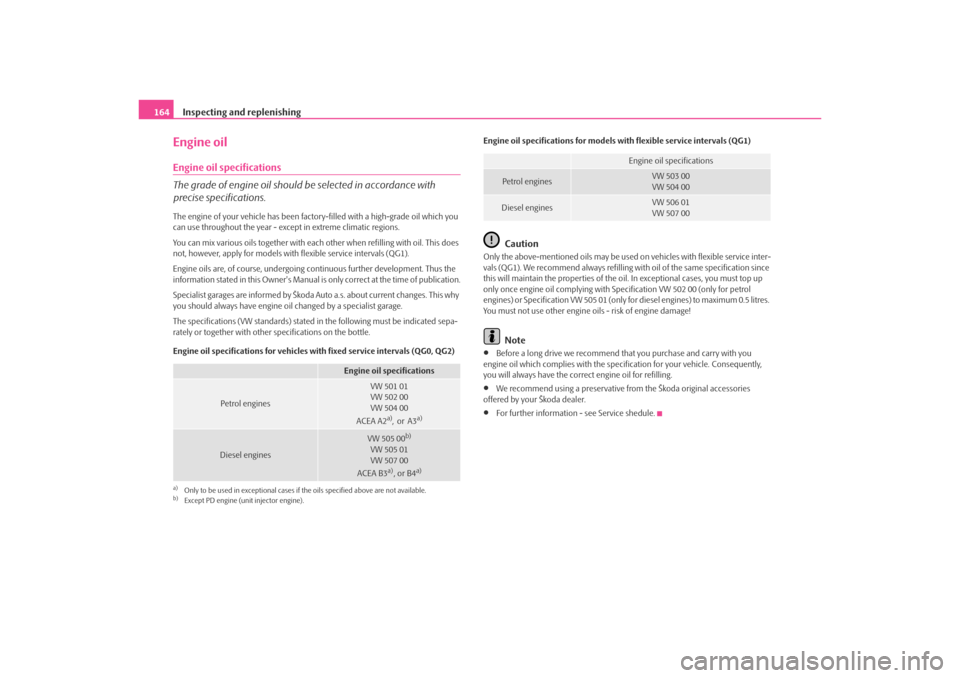
Inspecting and replenishing
164Engine oilEngine oil specifications
The grade of engine oil should be selected in accordance with
precise specifications.The engine of your vehicle has been fact ory-filled with a high-grade oil which you
can use throughout the year - exce pt in extreme climatic regions.
You can mix various oils together with each other when refilling with oil. This does
not, however, apply for models with flexible service intervals (QG1).
Engine oils are, of course, undergoing co ntinuous further development. Thus the
information stated in this Owner's Manual is only correct at the time of publication.
Specialist garages are informed by Škoda Auto a.s. about current changes. This why
you should always have engine oil changed by a specialist garage.
The specifications (VW standards) stated in the following must be indicated sepa-
rately or together with other specifications on the bottle.
Engine oil specifications for vehicles with fixed service intervals (QG0, QG2) Engine oil specifications for models with flexible service intervals (QG1)
Caution
Only the above-mentioned oils may be used on vehicles with flexible service inter-
vals (QG1). We recommend always refilling with oil of the same specification since
this will maintain the properties of the oi
l. In exceptional cases, you must top up
only once engine oil complying with Specification VW 502 00 (only for petrol
engines) or Specification VW 505 01 (only for diesel engines) to maximum 0.5 litres.
You must not use other engine oi ls - risk of engine damage!
Note
•
Before a long drive we recommend th at you purchase and carry with you
engine oil which complies with the specif ication for your vehicle. Consequently,
you will always have the corr ect engine oil for refilling.
•
We recommend using a preservative fr om the Škoda original accessories
offered by your Škoda dealer.
•
For further information - see Service shedule.
Engine oil specifications
Petrol engines
VW 501 01
VW 502 00
VW 504 00
ACEA A2
a), or A3
a)
a)Only to be used in exceptional cases if the oils specified above are not available.
Diesel engines
VW 505 00
b)
VW 505 01
VW 507 00
ACEA B3
a), or B4
a)
b)Except PD engine (unit injector engine).
Engine oil specifications
Petrol engines
VW 503 00
VW 504 00
Diesel engines
VW 506 01
VW 507 00
s2ig.book Page 164 Monday, November 10, 2008 11:20 AM
Page 166 of 226
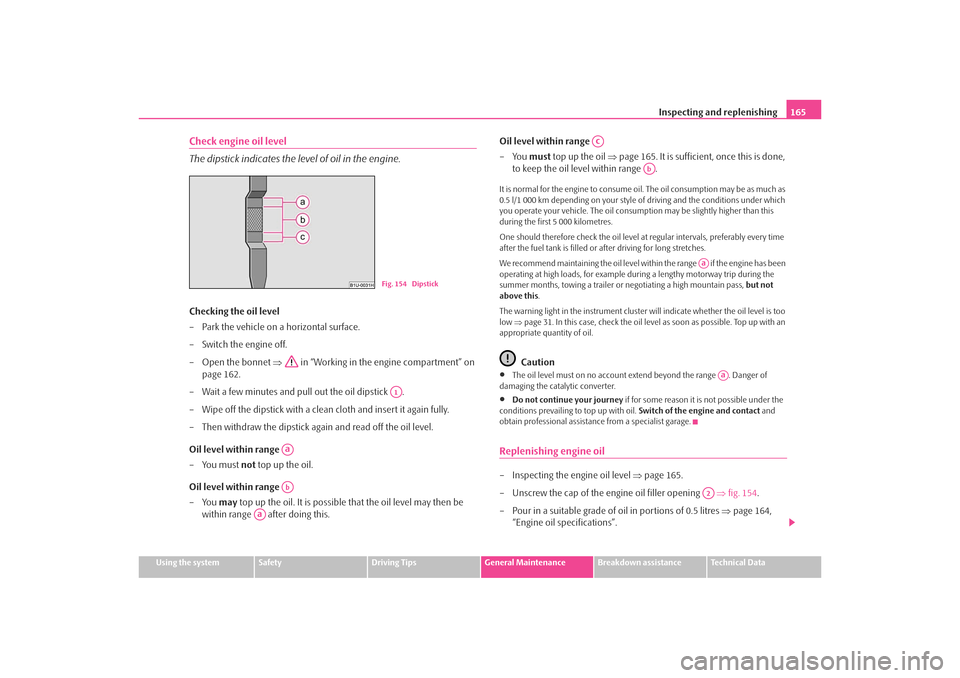
Inspecting and replenishing165
Using the system
Safety
Driving Tips
General Maintenance
Breakdown assistance
Technical Data
Check engine oil level
The dipstick indicates the level of oil in the engine.Checking the oil level
– Park the vehicle on a horizontal surface.
– Switch the engine off.
– Open the bonnet ⇒ in “Working in the engine compartment” on
page 162.
– Wait a few minutes and pull out the oil dipstick .
– Wipe off the dipstick with a clea n cloth and insert it again fully.
– Then withdraw the dipstick ag ain and read off the oil level.
Oil level within range
– You must not top up the oil.
Oil level within range
– You may top up the oil. It is possible that the oil level may then be
within range after doing this. Oil level within range
–You
must top up the oil ⇒page 165. It is sufficient, once this is done,
to keep the oil level within range .
It is normal for the engine to consume oi l. The oil consumption may be as much as
0.5 l/1 000 km depending on your style of driving and the conditions under which
you operate your vehicle. The oil consumpt ion may be slightly higher than this
during the first 5 000 kilometres.
One should therefore check the oil level at regular intervals, preferably every time
after the fuel tank is filled or after driving for long stretches.
We recommend maintaining the oil level within the range if the engine has been
operating at high loads, for example during a lengthy motorway trip during the
summer months, towing a trailer or negotiating a high mountain pass, but not
above this .
The warning light in the instrument cluster will indicate whether the oil level is too
low ⇒page 31. In this case, check the oil level as soon as possible. Top up with an
appropriate quantity of oil.
Caution
•
The oil level must on no account ex tend beyond the range . Danger of
damaging the catalytic converter.
•
Do not continue your journey if for some reason it is not possible under the
conditions prev ailing to top up with oil. Switch of the engine and contact and
obtain professional assistance from a specialist garage.
Replenishing engine oil– Inspecting the engine oil level ⇒page 165.
– Unscrew the cap of the engine oil filler opening ⇒fig. 154 .
– Pour in a suitable grade of oil in portions of 0.5 litres ⇒page 164,
“Engine oil specifications”.
Fig. 154 DipstickA1
AaAb
Aa
Ac
Ab
Aa
Aa
A2
s2ig.book Page 165 Monday, November 10, 2008 11:20 AM
Page 167 of 226
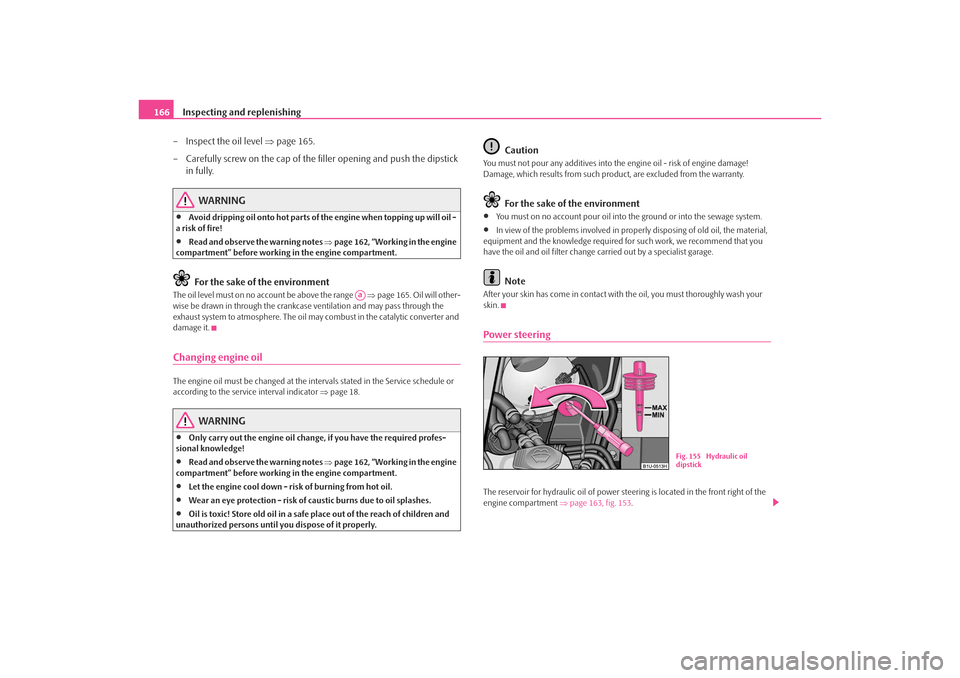
Inspecting and replenishing
166
– Inspect the oil level ⇒page 165.
– Carefully screw on the cap of the filler opening and push the dipstick
in fully.
WARNING
•
Avoid dripping oil onto hot parts of the engine when topping up will oil -
a risk of fire!
•
Read and observe the warning notes ⇒page 162, “Working in the engine
compartment” before working in the engine compartment.For the sake of the environment
The oil level must on no account be above the range ⇒page 165. Oil will other-
wise be drawn in through the crankcase ventilation and may pass through the
exhaust system to atmosphere. The oil ma y combust in the catalytic converter and
damage it.Changing engine oilThe engine oil must be changed at the intervals stated in the Service schedule or
according to the service interval indicator ⇒page 18.
WARNING
•
Only carry out the engine oil change, if you have the required profes-
sional knowledge!
•
Read and observe the warning notes ⇒page 162, “Working in the engine
compartment” before working in the engine compartment.
•
Let the engine cool down - risk of burning from hot oil.
•
Wear an eye protection - risk of caustic burns due to oil splashes.
•
Oil is toxic! Store old oil in a safe place out of the reach of children and
unauthorized persons until you dispose of it properly.
Caution
You must not pour any additives into th e engine oil - risk of engine damage!
Damage, which results from such produc t, are excluded from the warranty.
For the sake of the environment
•
You must on no account pour oil into the ground or into the sewage system.
•
In view of the problems involved in prop erly disposing of old oil, the material,
equipment and the knowledge required fo r such work, we recommend that you
have the oil and oil filter change carried out by a specialist garage.Note
After your skin has come in contact with the oil, you must thoroughly wash your
skin.Power steeringThe reservoir for hydraulic oil of power stee ring is located in the front right of the
engine compartment ⇒ page 163, fig. 153.
Aa
Fig. 155 Hydraulic oil
dipstick
s2ig.book Page 166 Monday, November 10, 2008 11:20 AM
Page 168 of 226
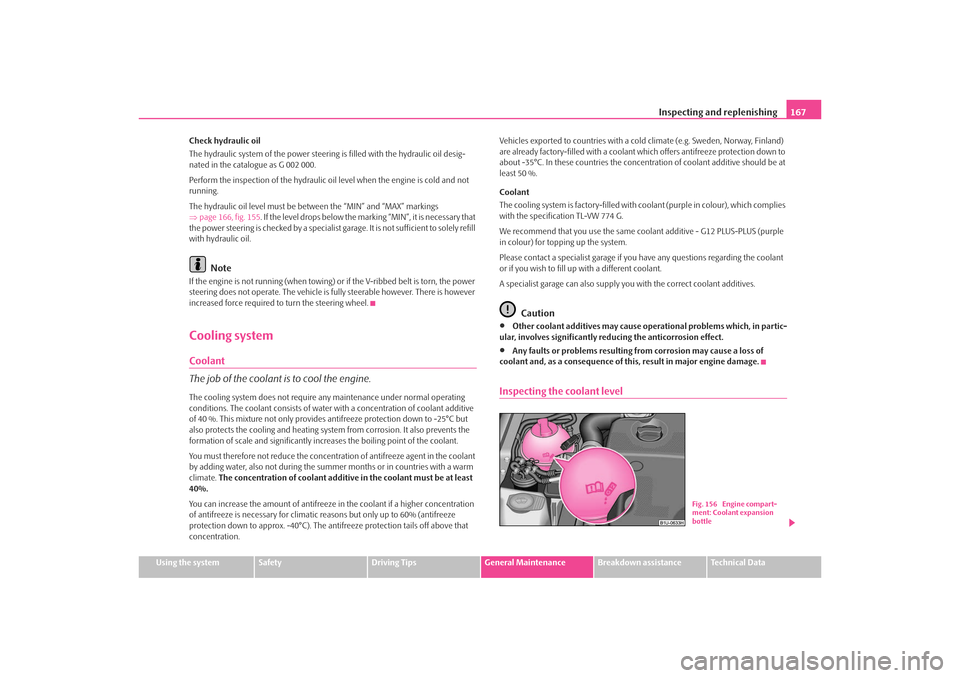
Inspecting and replenishing167
Using the system
Safety
Driving Tips
General Maintenance
Breakdown assistance
Technical Data
Check hydraulic oil
The hydraulic system of the power steering
is filled with the hydraulic oil desig-
nated in the catalogue as G 002 000.
Perform the inspection of the hydraulic oil level when the engine is cold and not
running.
The hydraulic oil level must be between the “MIN” and “MAX” markings
⇒ page 166, fig. 155 . If the level drops below the mark ing “MIN”, it is necessary that
the power steering is checked by a specialist garage. It is not sufficient to solely refill
with hydraulic oil.
Note
If the engine is not running (when towing) or if the V-ribbed belt is torn, the power
steering does not operate. The vehicle is fully steerable however. There is however
increased force required to turn the steering wheel.Cooling systemCoolant
The job of the coolant is to cool the engine.The cooling system does not require an y maintenance under normal operating
conditions. The coolant consists of water with a concentration of coolant additive
of 40 %. This mixture not only provides antifreeze protection down to -25°C but
also protects the cooling and heating system from corrosion. It also prevents the
formation of scale and significantly increases the boiling point of the coolant.
You must therefore not reduce the concentr ation of antifreeze agent in the coolant
by adding water, also not during the summ er months or in countries with a warm
climate. The concentration of coolant additive in the coolant must be at least
40%.
You can increase the amount of antifreeze in the coolant if a higher concentration
of antifreeze is necessary for climatic reasons but only up to 60% (antifreeze
protection down to approx. -40°C). The an tifreeze protection tails off above that
concentration. Vehicles exported to countries with a co
ld climate (e.g. Sweden, Norway, Finland)
are already factory-filled with a coolant which offers antifreeze protection down to
about -35°C. In these countries the concentr ation of coolant additive should be at
least 50 %.
Coolant
The cooling system is factory-filled with coolant (purple in colour), which complies
with the specification TL-VW 774 G.
We recommend that you use the same c oolant additive - G12 PLUS-PLUS (purple
in colour) for topping up the system.
Please contact a specialist garage if you have any questions regarding the coolant
or if you wish to fill up with a different coolant.
A specialist garage can also supply you with the correct coolant additives.
Caution
•
Other coolant additives may cause operational problems which, in partic-
ular, involves significantly reducing the anticorrosion effect.
•
Any faults or problems resulting from corrosion may cause a loss of
coolant and, as a consequence of th is, result in major engine damage.
Inspecting the coolant level
Fig. 156 Engine compart-
ment: Coolant expansion
bottle
s2ig.book Page 167 Monday, November 10, 2008 11:20 AM
Page 169 of 226
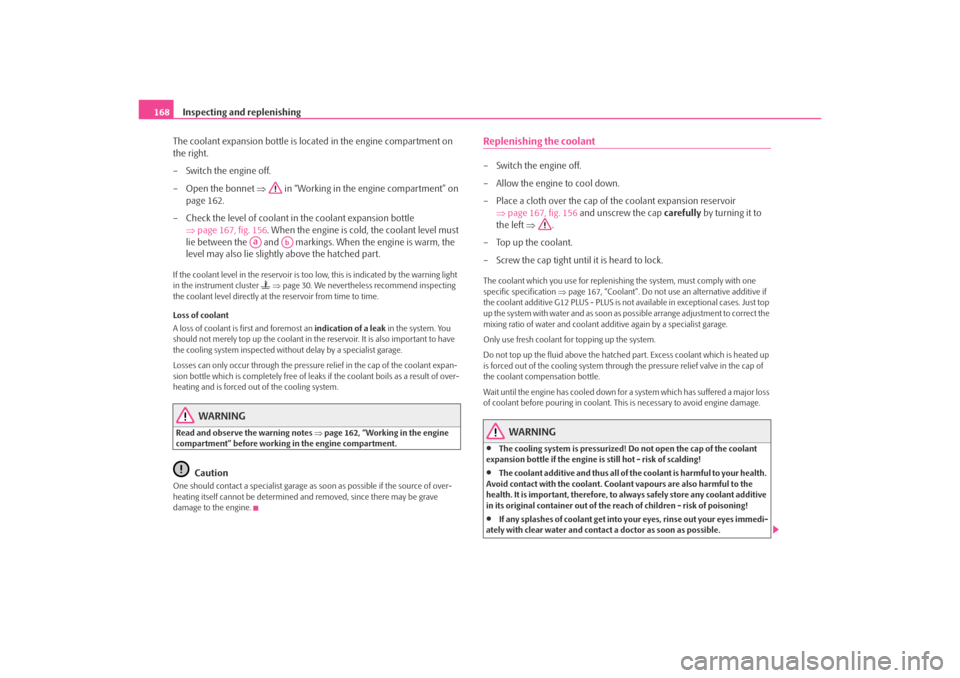
Inspecting and replenishing
168
The coolant expansion bottle is loca ted in the engine compartment on
the right.
– Switch the engine off.
– Open the bonnet ⇒ in “Working in the engine compartment” on
page 162.
– Check the level of coolant in the coolant expansion bottle ⇒page 167, fig. 156 . When the engine is cold, the coolant level must
lie between the and markings. When the engine is warm, the
level may also lie slightly above the hatched part.If the coolant level in the reservoir is too low, this is indicated by the warning light
in the instrument cluster
⇒ page 30. We nevertheless recommend inspecting
the coolant level directly at th e reservoir from time to time.
Loss of coolant
A loss of coolant is first and foremost an indication of a leak in the system. You
should not merely top up the coolant in the reservoir. It is also important to have
the cooling system inspected without delay by a specialist garage.
Losses can only occur through the pressure relief in the cap of the coolant expan-
sion bottle which is completely free of leak s if the coolant boils as a result of over-
heating and is forced out of the cooling system.
WARNING
Read and observe the warning notes ⇒page 162, “Working in the engine
compartment” before working in the engine compartment.
Caution
One should contact a specialist garage as soon as possible if the source of over-
heating itself cannot be determined and removed, since there may be grave
damage to the engine.
Replenishing the coolant– Switch the engine off.
– Allow the engine to cool down.
– Place a cloth over the cap of the coolant expansion reservoir ⇒page 167, fig. 156 and unscrew the cap carefully by turning it to
the left ⇒.
– Top up the coolant.
– Screw the cap tight until it is heard to lock.The coolant which you use for replenishing the system, must comply with one
specific specification ⇒page 167, “Coolant”. Do not use an alternative additive if
the coolant additive G12 PLUS - PLUS is not av ailable in exceptional cases. Just top
up the system with water and as soon as possible arrange adjustment to correct the
mixing ratio of water and coolant additive again by a specialist garage.
Only use fresh coolant for topping up the system.
Do not top up the fluid above the hatched part. Excess coolant which is heated up
is forced out of the cooling system throug h the pressure relief valve in the cap of
the coolant compensation bottle.
Wait until the engine has cooled down for a system which has suffered a major loss
of coolant before pouring in coolant. This is necessary to avoid engine damage.
WARNING
•
The cooling system is pressurized! Do not open the cap of the coolant
expansion bottle if the engine is still hot - risk of scalding!
•
The coolant additive and thus all of the coolant is harmful to your health.
Avoid contact with the coolant. Coolant vapours are also harmful to the
health. It is important, therefore, to always safely store any coolant additive
in its original container out of the reach of children - risk of poisoning!
•
If any splashes of coolant get into yo ur eyes, rinse out your eyes immedi-
ately with clear water and contact a doctor as soon as possible.
Aa
Ab
s2ig.book Page 168 Monday, November 10, 2008 11:20 AM
Page 170 of 226

Inspecting and replenishing169
Using the system
Safety
Driving Tips
General Maintenance
Breakdown assistance
Technical Data
•
You should also consult a doctor without delay if you have inadvertently
swallowed coolant.Caution
Do not continue your journey if for some reason it is not possible under the
conditions prevailing to top up with coolant. Switch of the engine and contact
and obtain professional assistance from a specialist garage.
For the sake of the environment
Do not re-use coolant if it is necessary to drain the coolant in the system. It should
be collected and disposed of in comp liance with environmental protection
regulations.Radiator fan
The radiator fan may switch on suddenly.The radiator fan is driven by an electric motor and controlled according to the
coolant temperature.
The radiator fan may continue running fo r up to 10 minutes after the engine has
been switched off - even if the ignition is also off. It may also switch on suddenly
after a certain time, if•
the coolant temperature has risen beca use of an accumulation of heat or
•
the warm engine compartment is heated up additionally by strong sunlight.
WARNING
You must therefore be aware when work ing in the engine compartment that
the fan may switch on suddenly - risk of injury!
Brake fluidInspecting the brake fluid levelThe brake fluid reservoir is located on the left of the engine compartment.
The brake fluid reservoir on right-hand steering models is positioned on
the other side of the engine compartment.
– Switch the engine off.
– Open the bonnet ⇒ in “Working in the engine compartment” on
page 162.
– Inspect the brake fluid level in the reservoir ⇒fig. 157 . The level must
be between the “MIN” and “MAX” markings.A slight drop in the fluid level results when driving due to normal wear-and-tear
and automatic adjustment of the br ake pads, and is perfectly normal.
There may be an indication of a leak in the brake system, however, if the fluid level
drops significantly within a short time or if it drops below the “MIN” marking. A situ-
ation where the brake fluid level is too low is indicated by the warning light
lighting up in the instrument cluster ⇒page 34. In this case stop immediately and
do not drive any further! Obtain professional assistance.
WARNING (continued)
Fig. 157 Engine compart-
ment: Brake fluid reservoir
s2ig.book Page 169 Monday, November 10, 2008 11:20 AM